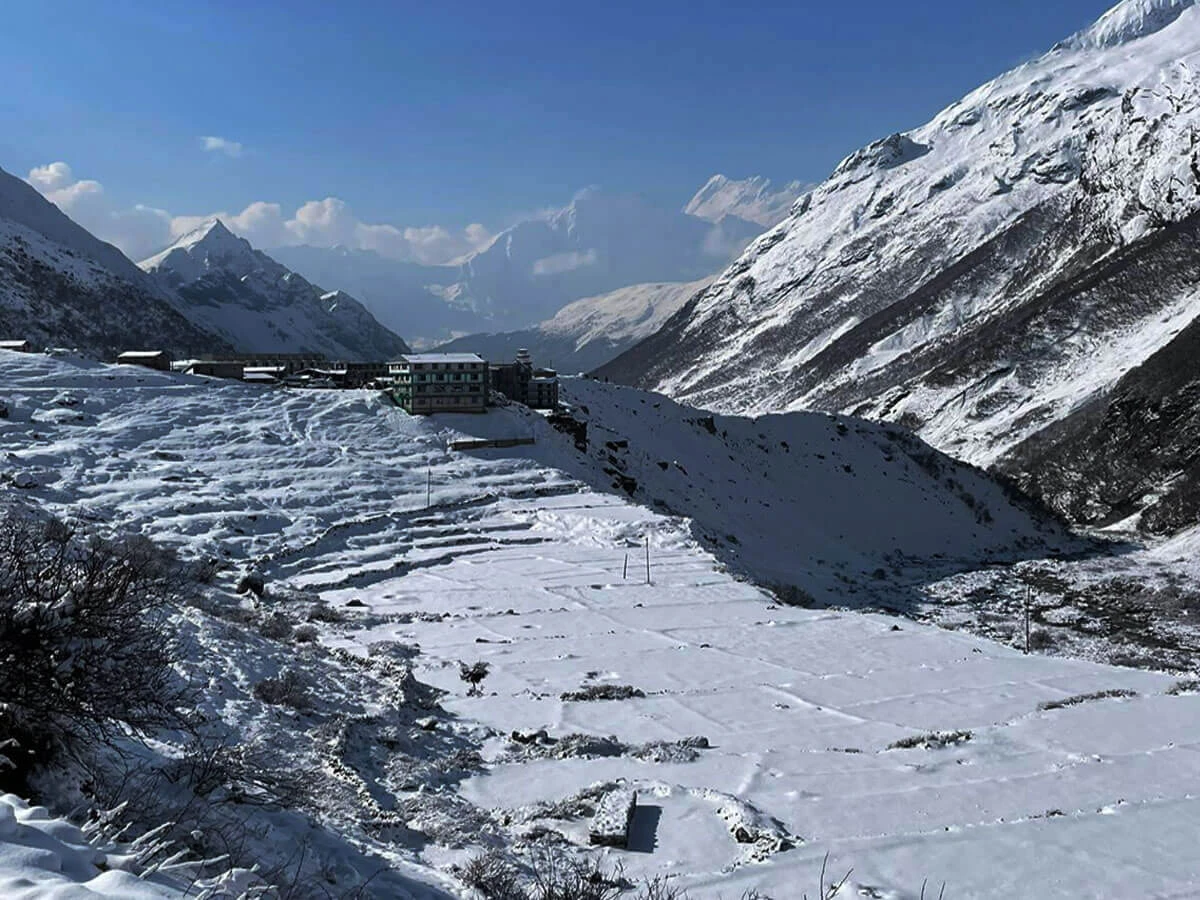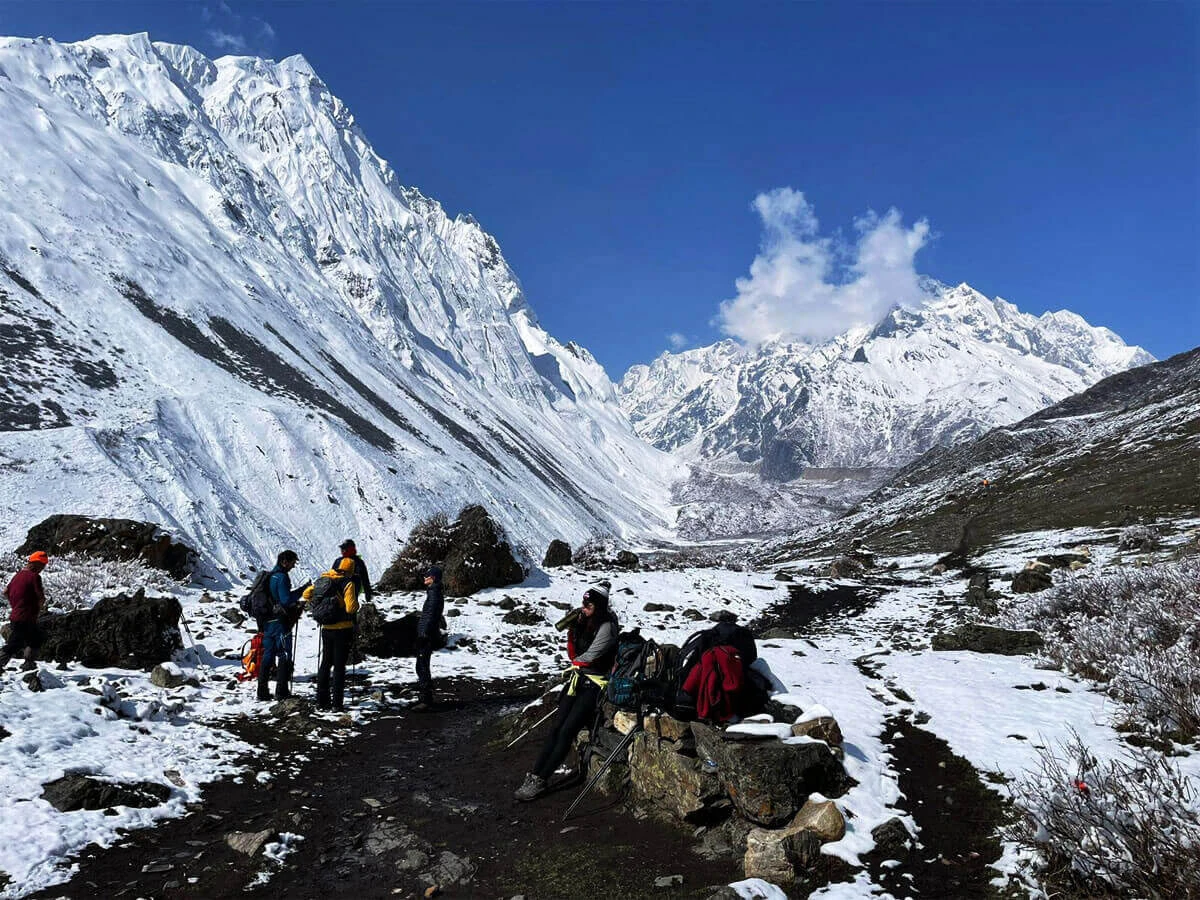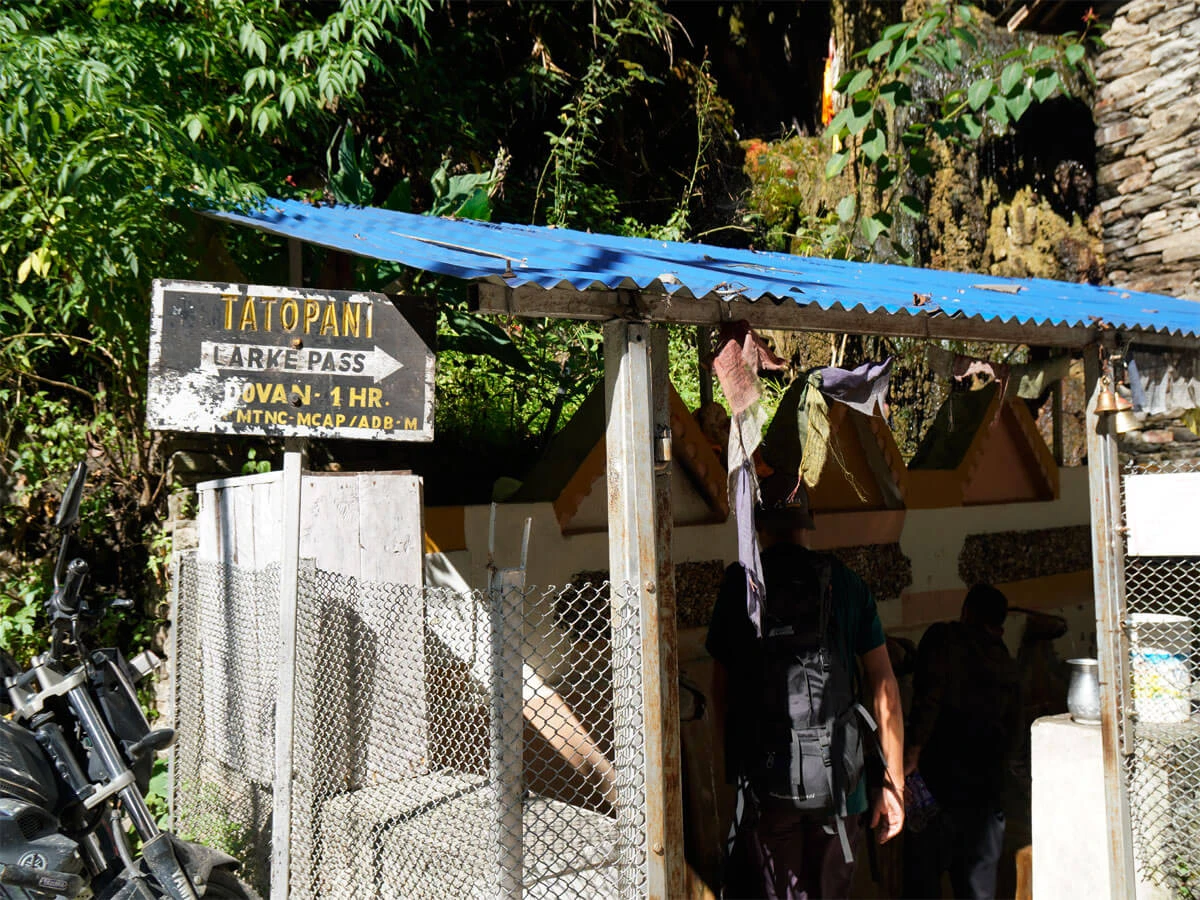The Short Manaslu Circuit Trek is a secluded journey that takes you to the beautiful Himalayas. Closed to the public until 1991 AD, this newly opened trekking route in Nepal traverses the offbeat trails, encountering the region’s natural beauty, stunning landscapes, and breathtaking vistas. Home to diverse ethnicities, the Manaslu Circuit journey further allows you to experience the diverse Himalayan cultures, embracing the region’s warm hospitality.
The off-the-beaten-path trails of the Manaslu region can be physically demanding. You will travel through alpine meadows consisting of rugged Himalayan terrains. The Manaslu Circuit Trek consists of many challenges. You will encounter several steep and strenuous uphill climbs, but the challenges are met with rewarding views of the mountains and the surroundings.
For example, the Larke Pass climb, the highest elevation point of the Manaslu Circuit Trek, gives you an immersive view of Ganesh Himal, the Manisri Himalayan Range, and other surrounding peaks. Likewise, the cultural heritage of the local communities is reflected as you trek from one destination to another. The trails proudly flaunt Buddhist monasteries adorned with prayer flags and prayer wheels.
Your journey across the Manaslu Circuit combines adventure, tranquility, and social experiences. The off-the-beaten trails of the region attract travelers wanting a peaceful trek in the heart of the Himalayas.
Why Go on the Short Manaslu Circuit Trek?
The Short Manaslu Circuit Trek is a journey across the hidden beauty of the Manaslu Himal. You will travel through the diverse terrain, experiencing its local culture along the way. This is a must-visit destination for a peaceful Himalayan trek. Here are the top reasons to trek the Manaslu Circuit.
Experience the Natural Beauty: You can experience beautiful landscapes on the Manaslu Circuit Trek. During the 12-day trek, you will transition from vast grasslands and lush forests of the low-altitude valleys into the rugged alpine meadows. The trail gradually showcases the natural diversity and beauty of the region.
Unique Local Culture: There are diverse local ethnicities along the Manaslu Circuit. In the lower regions, you will find Brahmin, Chhetri, and Magar communities. Likewise, the high altitude mostly consists of Gurung and Tibetan settlements. Likewise, you will also find the Numbri and Tsum people, two major sub-ethnic groups. Each community flaunts its unique culture and customs. Take some time to interact with the locals and immerse yourself in their culture.
Lesser Crowd: You can travel peacefully while trekking the Manaslu Circuit. Unlike the more popular treks, the offbeat trails takes you away from the touristy crowds that you would typically find in Annapurna Base Camp and Poon Hill trails. This is a perfect getaway if you want to travel in the Himalayas in peace and solitude.
High-Altitude Adventures: The Manaslu Circuit Trek takes you to points above 5000 meters in the Himalayas. You will trek to the Larkya La Pass, at an elevation of 5100 meters – the highest destination of the trek. From here, you can enjoy the beautiful views of Ganesh Himal, the Manisri Himalayan Range, and several other mountains.
Short Manaslu Circuit Trek Permit
Trekkers need the following permits to complete the Manaslu Circuit Trek in Nepal.
Manaslu Restricted Area Permit (MRAP): The Manaslu Restricted Area Permit aims at protecting the biodiversity and cultural heritage by controlling tourist flow. The prices of the permits vary from one season to another.
Manaslu Conservation Area Project (MCAP) Permit: The Manaslu Conservation Area Project (MCAP) permit is mandatory for all trekkers. You will find it at the Philim checkpoint, the starting point of the Manaslu Conservation Area.
Annapurna Conservation Area Program (ACAP) Permit: The Annapurna Conservation Area Project is available at the Nepal Tourism Board offices in Kathmandu and Pokhara. It aims to protect the area's natural and cultural resources.
Traveling with Index Adventure eliminates the hassle of lining up at government offices for your permits. All required Manaslu Circuit Trek permits are included in our package.
12-Day Short Manaslu Circuit Trek: Cost for Transportation, Permits, Guides, and Porters
The cost for a 12-day Short Manaslu Circuit Trek is based on several factors. Your group size, number of trekking days, luxury preferences, modes of transport, day extensions, and additional services add to the final cost of the trek. For a standard trek cost, you can check out our fixed departure 12-day Manaslu Circuit Trek packages.
Our standard packages generally include all necessary services, including one guide, one porter, meals on trek, accommodation, and other services. With Index Adventure, you can rest assured of the prices. We deliver the best Manaslu Circuit Trek packages at reasonable costs.
Major Highlights of the 12-Day Short Manaslu Circuit Trek in Nepal
- Breathtaking views of the stunning Himalayas
- Adventurous journey along alpine meadows leading to the trek’s highest point—the Larkya La Pass
- The diverse terrain and breathtaking landscapes during the trek
- Cultural immersion of the diverse ethnic communities
- Offbeat trekking trails and the impressive topography of the Manaslu Circuit Trek amid peace and serenity
- The beautiful flora and fauna of the Manaslu region
- Best Time for Manaslu Circuit Trek in 2026 and 2027
While trekking to the Himalayas, it is crucial to plan ahead of time. This helps you avoid potential weather-related threats and prepare accordingly. While the preferences may vary, spring months (March to May) have ideal weather conditions and are considered the best time for the Manasalu Circuit Trek.
In spring, the temperatures are mild with chances of sporadic afternoon showers. Furthermore, the lush terrain of the Manaslu region provides beautiful wildflowers and blossoming rhododendrons, engulfing the entire landscape.
Autumn (September to November) is another ideal time for trekking the Manaslu Circuit. With the end of the monsoon, the rain starts to subside. Temperatures are moderate throughout this season. Daytime temperatures are mild, while it can get chilly at night.
The winter season (December to February) in the Himalayas is cold. Temperatures remain below freezing, especially in the higher-altitude regions. Trekking the Manaslu Circuit in winter is still possible, but with adequate preparations.
Monsoon trekking (June to July) is not recommended. Due to heavy rainfall, landslides and floods are evident. Also, the trekking routes are slippery, with imminent risks of accidents and injuries. Trekking in the monsoon season is recommended only to highly experienced trekkers.
In recent years, global warming has caused a shift in weather patterns. This causes unexpected climate change, making the Himalayas more unpredictable. We strongly suggest that travelers check the weather forecast before planning the trek to the Himalayas. Alternatively, you can contact us to discuss trekking possibilities.
Short Manaslu Circuit Trek: A Typical Day
A typical day on the Manaslu Circuit Trek begins with breakfast. You can prepare for day day's journey, enjoying the beautiful mountain views. Next, you begin your trek. You will pass through varying landscapes and terrains, including lush forests, rivers, and narrow ridges. While the lower-altitude regions are known for their lush vegetative landscapes, you will find alpine meadows and rugged terrain in the higher elevation regions.
Along the way, you will stop for lunch at a local settlement where you will find interesting cultures and heritages. Feel free to interact with the hospitable locals; ask about their culture and lifestyle.
In the late afternoon or early evening, you will complete the day's trek. In the teahouse, at the day's destination, you can unpack and get some rest. Later, you have the option to explore the nearby attractions to take in the beauty of the surroundings.
You will end your day with a warm dinner before heading to bed.
How Hard is the Short Manaslu Circuit Trek?
The Short Manaslu Circuit Trek is a moderately challenging journey around Manaslu. You need good physical strength and stamina to complete this trek. Your mental preparedness is equally important, as you will go through several challenges, including difficult ascents and rugged alpine sections.
The trek requires you to hike 6 to 8 hours daily through steep ascents and Himalayan terrain. You will reach a maximum elevation of 5,160 meters at the Larkya La Pass, which further tests your physical and mental preparedness.
The Short Manaslu Circuit Trek is mostly recommended to trekkers with prior experience. Beginners should prepare adequately to complete this trek. Furthermore, to make this trek more memorable, always follow the instructions of your expert guides.
Altitude Sickness and Precautions
The Short Manaslu Circuit Trek is a high-altitude trek with chances of altitude sickness. To avoid its risks, remember to walk at a comfortable pace and stay hydrated at all times.
To minimize the risks of altitude sickness, we have a rest day at Samagoan. In case you experience symptoms related to altitude sickness, you should inform your guide immediately. While most symptoms are cured with sufficient rest, nutritious food, and basic medication, severe cases will require a lower-altitude descent or even a helicopter rescue.
Short Manaslu Circuit Trek: Necessary Gear and Equipment
Here is a list of necessary gear and equipment for the Manaslu Circuit Trek:
Clothing: Base layers, insulating layers, and outer shell layers for weather protection.
General Trekking Gear: Trekking attire (pants, t-shirts, and shorts), a waterproof jacket and trousers, and undergarments.
Headgear: sun hat, beanie, and neck gaiter.
Hand and Footwear: Liner gloves, insulated outer gloves, hiking boots, trekking shoes, sandals, comfortable hiking socks, thermal socks, and gaiters.
Bags and Packs: Duffel bag, backpack, daypack, rain cover, and dry bag.
Sleeping Gear: Sleeping bag, sleeping bag liner, and earplugs.
Trekking Accessories: Trekking poles, sunglasses, and a headlamp.
Other Essentials: Water bottle/hydration bladder, quick-dry towel, female urination device, locks, and waterproof bags.
Optional Extras: Camera, portable charger, books/playing cards, passport, and cash.
What are other alternatives to the 12-day Short Manaslu Circuit Trek in Nepal?
The Short Manasalu Circuit Trek in Nepal takes you through the vast wilderness along the offbeat trails. While this may be ideal for experienced trekkers looking to spend a quiet time in nature, others may choose a comfortable and shorter trek. We have compiled the top 3 alternative treks suitable for such travelers:
Mardi Himal and Poon Hill Trek: The Mardi Himal and Poon Hill trek consists of two of the most iconic trekking destinations. You can complete this trek in a short period. On both journeys, you can enjoy spectacular views of the Annapurna and the Dhaulagiri range, Machhapuchhre Himal, Hiunchuli, and other surrounding peaks. From Poon Hill, you can enjoy the stunning sunrise views. Likewise, the view of the Machhapuchhre from the Mardi Himal Base Camp is equally stunning.
Everest Base Camp Trek: The Everest Base Camp trek is among the most popular trekking destinations in Nepal. Trekkers who have been on this scenic journey often share experiences of warm hospitality and the cultures of the local communities. As you travel from one destination to another, you can enjoy the magnificent views of Lhotse, Makalu, Lhotse Shar, Cho Oyu, Nuptse, Ama Dablam, Pumori, and other iconic peaks.
Index Adventure also provides shorter Manaslu circuit trekking. Or, if you are looking for a more comprehensive Himalayan adventure, you can combine other trekking routes, like the Tsum Valley Trek or the Manaslu-Annapurna Circuit Trek.




